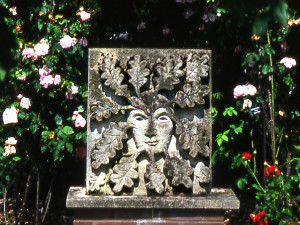Last weekend, I found the gardenalia store of my dreams in a Pennsylvania town. Like many wondrous finds, it happened by accident. Like many wondrous finds in the northeastern United States, it happened because I couldn’t find a parking place.
As I walked the half mile from the parking lot to my destination—a quaint village center full of interesting shops—I caught sight of a very large fountain. Crossing the street to get a better look, I discovered that the fountain sat in front of a double lot overflowing with garden ornaments. The array was staggering and ranged from formidable cast-concrete statues to minute wrought iron finials, no doubt salvaged from long-lost fences. Without even turning my head, I could see a three-foot wide terra cotta plaque depicting the Greek goddess Aphrodite, a life size, cast-concrete representation of a hedgehog peering out of a flowerpot; and a selection of decorative wrought iron pieces. The place was a veritable statuary zoo, with inmates that included winged pigs, seated cats, dragons, lions, cranes and whippets, all cheek by jowl with garlanded metal planter boxes and marble garden benches. Fountains ranged from small, easily transportable models to behemoths that would require heavy-duty forklifts and special transportation, not to mention the services of plumbers, landscape architects and installers with the strength of Hercules.
In the midst of this feast of gardenalia, I saw a figure that has interested me for my entire gardening career—the Green Man.
You may not know the name, but if you have spent time in the world of horticultural ornaments, studied decorative motives of old European cathedrals, or even thumbed through mass market garden equipment/accessories catalogs, you have seen the Green Man. An embodiment of the spirit of nature, he is frequently represented as a head with a human face encircled by stylized leaves in place of hair and beard. Sometimes the leaves are acanthus, sometimes oak or ivy, and the face can be jovial or serious, depending on the whim of the artist. Some Green Man representations may feature plants emerging from the nose, mouth or eyes.
The gardenalia store carried a number of Green Man plaques, including one that gave the Green Man a tree-like body. Some Green Men were even painted green, which I think is overkill and distracts from the carving. To each his own.
Literature is full of lofty analyses of the Green Man’s origins and I am quite sure he has launched many doctoral dissertations. He looks a little like some representations of Dionysus, the Greek god responsible for fertility, in addition to all kinds of frivolity. He might be a descendant of ancient nature deities, like Silvanus, the Roman god of the woods. Going back even further, the Green Man may also be related to Osiris, the Egyptian god of growing things, who was sometimes portrayed with a green face.
No good historical mystery is complete without some reference to the Knights Templar, the military/religious order that was born during the Crusades and existed from the twelfth through fourteenth centuries. The Green Man is no exception. Some Templar churches in France, Germany and England feature Green Man carvings among their decorative motives. It is possible that when the Templars returned from the Middle East, they brought the idea back with them and adapted it for use in their houses of worship.
Depending on the source, the Green Man may also have ties to English folklore figures like Robin Hood. He may also have found his way into Arthurian legend, appearing as the colorful title character in the story “Sir Gawain and the Green Knight.”
Whatever the origins of the Green Man, he certainly travels laden with historical significance. But what will that do for your garden?
A Green Man plaque hanging on a gate, fence or wall, will not attract hummingbirds, fertilize the desirable plants or kill off the weeds. But with nature under siege in so many places, having your own personal Green Man may remind you to take extra care in tending your little piece of it.

